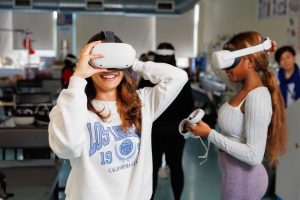7 BioVision: Exploring Anatomy and Physiology Through Virtual Reality
Dr Anne-Marie O'Brien and Dr Natasha McCormack
Programme: BSc Pharmacology
Module: Human Anatomy, Physiology and Pathophysiology
Year: 2
Aim: to introduce students in Pharmacology to anatomy and physiology through the virtual reality app 3D Organon.
Learning Outcomes linked to the VR activity:
1. Enhanced Anatomical Understanding of the major structures and anatomical features of the cardiovascular and hepatic systems.
2. Understanding Physiological Functions of the cardiovascular system such as blood circulation, oxygen and nutrient delivery, and waste removal.
Description of the VR activity
In this VR-based lab practical, students embarked on an immersive exploration of the cardiovascular and hepatic systems. They navigated through detailed 3D models of the cardiovascular and hepatic systems. They identified and described the heart, arteries, veins, capillaries, liver, hepatic arteries, portal vein, and bile ducts. Additionally, through interactive simulations, students observed and described some of the physiological processes in the cardiovascular system, in the hepatic system.
They also utilised the VR headsets and accompanying app (3D Organon) to examine the spatial relationships and intricate details of the anatomical structures. They completed tasks that required precise identification and annotation of these structures to enhance their understanding. The immersive nature of the VR activity boosted student engagement and motivation. Students participated in discussions within the VR environment, fostering a positive attitude towards innovative learning methods and enhancing their overall learning experience. This VR activity provided a hands-on, interactive approach to learning that reinforced anatomical and physiological concepts while leveraging cutting-edge technology to make complex systems accessible and engaging.
Lecturers’ Reflections
Integrating VR technology into the Human Anatomy, Physiology and pathophysiology lab practical has been a very positive experience for both students and lecturers. Reflecting on this pilot study, a few key observations and insights have emerged.
- Enhanced Anatomical Understanding: VR has improved students’ ability to identify and describe anatomical structures. The detailed 3D models provided a level of clarity and realism that traditional textbooks and 2D images cannot match. Students were able to explore the heart, blood vessels, liver, and associated structures in an immersive environment, which facilitated a deeper understanding of spatial relationships and anatomical details.
- Understanding Physiological Functions The dynamic simulations made abstract concepts tangible, leading to more effective learning outcomes.
 Students quickly adapted to the VR tools, and the interactive nature enhanced their technical skills and fostered critical thinking as they identified and annotated various structures. There was a heightened level of student engagement and motivation as the immersive VR environment captured their attention and made learning enjoyable. Students expressed positive attitudes towards the use of VR, appreciating its ability to make complex subjects more accessible and interesting.
Students quickly adapted to the VR tools, and the interactive nature enhanced their technical skills and fostered critical thinking as they identified and annotated various structures. There was a heightened level of student engagement and motivation as the immersive VR environment captured their attention and made learning enjoyable. Students expressed positive attitudes towards the use of VR, appreciating its ability to make complex subjects more accessible and interesting.
While the overall experience was positive, there were some challenges. As this was a lab-based subject and the class was split to use the VR it was necessary to have additional lab support during the VR session which incurred additional cost. Also, there was a learning curve associated with mastering the VR controls.
Conclusion: Using VR in this lab practical has proven to be a valuable educational tool, enhancing anatomical and physiological understanding, student engagement, and technical proficiency. Moving forward, [we] excited to continue integrating VR into the curriculum and exploring its potential in terms of the way we teach and learn complex concepts. This could also be very valuable for other lab practicals, where it can take the place of or enhance traditional dissection labs ( e.g., heart, kidney). There is significant potential for VR to become an integral part of our teaching strategy, offering opportunities for immersive and interactive learning.
Student feedback:
“It was incredible to see the anatomical structures and to move them around and see inside them and under them.”

